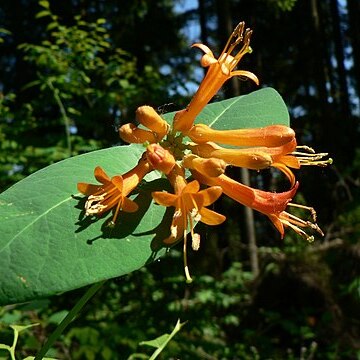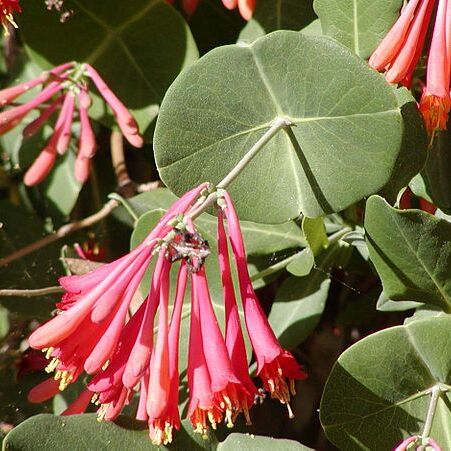2-flowered cymes (dichasia) and bracteate and bracteolate or in sessile verticels of 3-flowered dichasia, the bracts sometimes foliaceous, the bracteoles sometimes connate and enveloping the ovary; pedicels short of wanting. Flowers fragrant, often showy, bisexual, 5-merous;. calyx-tube elliptical or rotund, glabrous or pubescent, sometimes glaucous, the lobes small or obsolete; corolla variously colored, sometimes fading to a different color, rarely regular, mostly strongly 2-lipped and slightly ventricose or variously saccate, gibbous, or spurred, glabrous or pubescent and with 1-5 nectaries along the inside of the tube, the lobes quin-cunical in bud; stamens 5, subequal, the filaments slender, the posterior 3 inserted in the corolla tube slightly above the anterior 2, the anthers oval to oblong or narrowly elliptical, straight in bud but in flower sometimes recurving at both ends, dorsifixed and versatile, mostly exserted, the 4 locules sometimes partly confluent, dehiscing introrsely by longitudinal lateral slits; the ovary inferior, sometimes connate with that of the adjacent flower, 2-3(-5)-loculed, the ovules 3-8 per locule, pendulous from the top of the ovary, anatropous, the style elongate, slender, glabrous or pubescent, the stigma small, indistinctly-lobed. Fruit a juicy or fleshy few-seeded berry, often shiny and bright-colored, rarely enveloped by accrescent bracteoles, mostly surmounted by the persistent calyx lobes; the seeds compressed, ovoid with smooth or granular testa, the endosperm fleshy, the embryo terete, minute, straight or slightly curved, the cotyledons terete.
Shrubs or (in Malaysia exclusively) woody climbers twining to the right, or, in the absence of sufficient support, locally scrambling shrubs; bark at last lengthwise splitting, twigs mostly contorted. Leaves hairy or glabrous, entire (in the Malaysian spp.), free (or in extra-Malaysian subg. Periclymenum) connate. Stipules absent, but leaf-bases connected by a raised line on the node. Flowers 5-merous, mostly sessile, in 2-flowered, axillary, peduncled or rarely almost sessile cymes, not rarely specially developed towards the end of the branches and forming a leafy terminal panicle. Cymes occasionally 3-flowered. Each pair of flowers subtended by 2 bracts and 4 bracteoles, the latter sometimes covering the ovary. Calyx-tube ovoid or subglobose, teeth mostly small. Corolla elongated, mostly 2-lipped, upper lip representing 4 lobes, and mostly 4-lobed at its apex, lobes imbricate in bud. Stamens 5, anthers introrse, mostly exserted; filaments inserted near the apex of the tube. Ovary 2-3-celled, style filiform, elongated, usually exsert, and exceeding the stamens, stigma capitate. Ovules axile, 3-8 per cell, pendulous. Berries mostly few-seeded, free or (in extra-Malaysian spp.) connate in pairs. Seeds generally ovoid with fleshy albumen and a terete embryo.
Deciduous or evergreen, climbing or erect shrubs. Stems hollow or with brown or white pith. Winter buds with 2 or several outer scales. Lvs entire, rarely lobed, usually exstipulate, rarely stipulate. Fls generally fragrant, either in axillary pedunculate pairs and each pair with 2 bracts and 4 bracteoles, or in sessile axillary whorls or terminal heads. Calyx small or minute, 5-toothed. Corolla 5-lobed, nearly regular or ± irregular, sometimes bilabiate; tube short or long, sometimes gibbous. Stamens 5, included or exserted. Ovary 2-3-(5)-celled, adjacent walls in paired fls sometimes united. Styles slender; stigma capitate. Fr. a few-or sometimes many-seeded, berry.
Cor tubular or funnelform, mostly conspicuous, deeply or shallowly 5-lobed, often bilabiate with a 4-lobed and a 1-lobed lip, the tube often gibbous or spurred at base; cal short, 5-toothed; stamens 5; ovary 2–3-locular with several ovules per locule; style elongate; stigma capitate; fr a few-seeded berry; erect shrubs or trailing or twining vines, with simple, mostly entire lvs; infl terminal, of 1–few 6-fld whorls, or axillary, the peduncles then bearing a pair of terminal sessile fls, their ovaries sometimes united. 180, N. Hemisphere. (Nintooa, Phaenanthus, Xylosteon)
Vines, shrubs, or small trees, mostly pubescent with simple, several-celled hairs, some with transparent terminal glands which often dry reddish-brown; branches fistulose or solid. Leaves evergreen or deciduous, simple, mostly entire, paired, some pairs sometimes connate-perfoliate, glabrate or pubescent, sometimes glaucous beneath, membranaceous, coriaceous, or succulent, petiolate, mostly estipulate, bud scales often present. Inflorescences mostly numerous, pedunculate,


